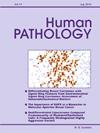Clinicopathologic findings in native liver biopsies after heart transplantation and total artificial heart implantation
IF 2.6
2区 医学
Q2 PATHOLOGY
引用次数: 0
Abstract
Liver biopsy is common before heart transplantation to assess for advanced fibrosis that could require combined heart-liver transplantation. While congestive hepatopathy is common in these biopsies, little is known about what happens in the native liver after heart transplantation. In this study, 1300 adult heart explants were identified at a single institution, 38 of which had subsequent native liver biopsies (2.9 %), including 31 after orthotopic heart transplantation (OHT) and 7 after total artificial heart (TAH) implantation. Presentation was variable, but similar overall between post-OHT and post-TAH patients, with elevated liver function tests being the most common indication for liver biopsy (15/38; 39.5 %), and AST levels being significantly higher in post-TAH patients than post-OHT patients (mean: 172.4 vs. 59.8 U/L, respectively; p = 0.0077). A wide variety of histological patterns was seen, but the most common was a vascular outflow impairment pattern in 11/38 (28.9 %) patients. Fibrosis was predominantly mild (23/38; 60.5 %), with advanced fibrosis in 5 (13.2 %), no fibrosis in 6 (15.8 %), and insufficient parenchyma for evaluation in 4 (10.5 %). Fewer than half of patients with vascular outflow impairment pattern had a clinical diagnosis of heart failure, suggesting alternative etiologies of vascular injury in post-OHT/TAH patients.
心脏移植和全人工心脏植入术后肝脏活检的临床病理表现
肝活检通常在心脏移植前用于评估晚期纤维化是否需要联合心脏-肝移植。虽然充血性肝病在这些活组织检查中很常见,但对心脏移植后的原生肝脏发生的情况知之甚少。在本研究中,在一家机构鉴定了1300例成人心脏移植,其中38例(2.9%)随后进行了原生肝活检,其中31例在原位心脏移植(OHT)后,7例在全人工心脏(TAH)植入后。表现各不相同,但oht后和tah后患者总体上相似,肝功能检查升高是肝活检最常见的指征(15/38;39.5%),并且tah后患者的AST水平显著高于oht后患者(平均:172.4 vs 59.8 U/L;p = 0.0077)。组织学模式多种多样,但最常见的是血管流出损害模式(11/38)(28.9%)。纤维化以轻度为主(23/38;60.5%), 5例晚期纤维化(13.2%),6例无纤维化(15.8%),4例缺乏可评估的实质(10.5%)。不到一半的血管流出障碍患者临床诊断为心力衰竭,提示oht /TAH后患者血管损伤的其他病因。
本文章由计算机程序翻译,如有差异,请以英文原文为准。
求助全文
约1分钟内获得全文
求助全文
来源期刊

Human pathology
医学-病理学
CiteScore
5.30
自引率
6.10%
发文量
206
审稿时长
21 days
期刊介绍:
Human Pathology is designed to bring information of clinicopathologic significance to human disease to the laboratory and clinical physician. It presents information drawn from morphologic and clinical laboratory studies with direct relevance to the understanding of human diseases. Papers published concern morphologic and clinicopathologic observations, reviews of diseases, analyses of problems in pathology, significant collections of case material and advances in concepts or techniques of value in the analysis and diagnosis of disease. Theoretical and experimental pathology and molecular biology pertinent to human disease are included. This critical journal is well illustrated with exceptional reproductions of photomicrographs and microscopic anatomy.
 求助内容:
求助内容: 应助结果提醒方式:
应助结果提醒方式:


